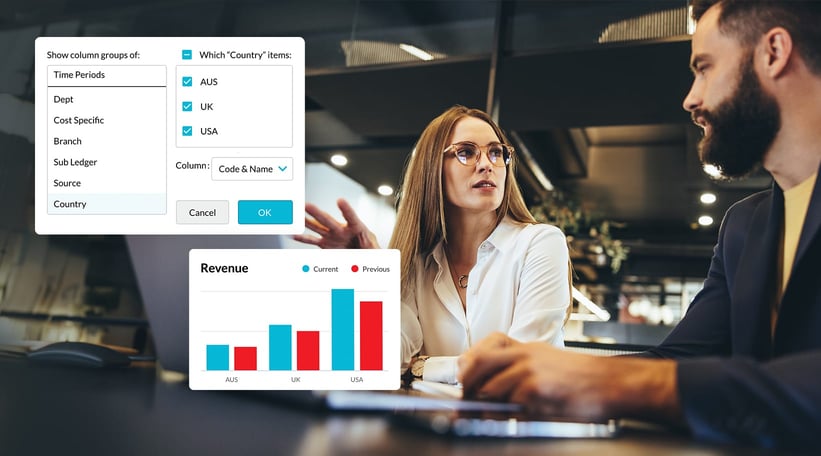Need a faster month end close?

Accountants can be their own worst enemies. Why? Because they always deliver month-end reports even though it can be a particularly time-consuming process. That’s their job and because most finance people are diligent and task orientated — they get all the account reconciliations and the job done.
What is the month end close process?
The month-end close process is a comprehensive review of a company’s financial activities and performance for the month, culminating in the preparation of accurate financial statements. This process ensures consistency and accuracy of accounting procedures, laying the groundwork for seamless quarterly and year-end financial closes.
Here’s a streamlined overview of the key steps in the month-end close process:
- Record all customer invoice payments and vendor invoices in the accounting system.
- Reconcile bank accounts/bank statements and inventory assets.
- Generate financial statements - profit and loss statement, balance sheet, cashflow statement
- Review financial statements thoroughly for accuracy
- Close the accounting period in your system
- Distribute finalized financial statements to cfo and then all stakeholders
- Prepare for the next closing cycle such year-end close.
What does the month-end process look like in your business?
Does your finance team spend a lot of time pulling data from your enterprise resource planning (ERP) system into Excel spreadsheets, then manipulating it into a standardized format? Is there a lot of wasted effort, double-checking and renaming? For many, the process of preparing financial reporting data is a huge time waster, meaning less time spent on value-add activities like analyzing the data and meeting your month-end closing date. A modern finance solution allows the accounting department to quickly customize and automate financial statements, reducing the end-of-the-month close from days to hours.
Implementing modern accounting software can transform the month-end close checklist, automating tasks like accounting reconciliations, managing accruals, tracking depreciation, and ensuring smooth handling of accounts payable and accounts receivable. By doing so, you can reduce the time spent on the end closing process from days to hours
The state of month-end close efficiency
A study by the American Productivity & Quality Center (APQC) highlights the disparity in the monthly close process time among companies:
- The bottom 25% of companies take 10 or more days to close their books.
- The top 25% manage it in just 4.8 days or less.
- The median close time is 6.4 days.
When you streamline your processes with the right accounting system, your organization can join the ranks of top performers who close their books in record time.
Faster month-end close with financial automation
The Phocas BI and FP&A platform offers an integrated accounting system that accelerates the month-end close. It includes financial statement software that automates the creation of profit and loss (income statement), balance sheet and cashflow statements. The financial statement software is built on a business intelligence foundation,with real-time data integrations from your ERP to ensure your financial records are always accurate and up-to-date.
Finance teams can freely explore financial data and drill down to transactional level (without touching the general ledger) in just a few clicks. Insights can be visualized with unlimited custom dashboards, charts and graphs, then shared with branches, divisions or individuals. Making it easy to connect more people to the financial health of your business.
Access and security are defined at a user level, enabling the finance team to quickly build financial statements customized to users’ access. So, branch managers can see information relevant to their branch, and management can see information across the whole business.
Statements can also sit across one or many ERPs so leaders can view the individual company, branch, regional performance and even the consolidated performance when required. The benefit of using this software means accounting teams only need to build the report once and then it automatically updates throughout the month to provide a real-time view of financial performance.
Now that preparing the financial statements is faster and simpler, the finance team can move away from manual number crunching and spend more time on in-depth analysis and facilitating more informed business decisions. By preparing financial statements within a data analytics environment, you can quickly compare statements from one traditional period or outside of these timeframes - say one week to the next.
Key benefits include:
Automated updates: Financial reports update automatically throughout the month, eliminating repetitive tasks and enabling instant insights.
Seamless reconciliations: Effortlessly match and correct incoming cash and discrepancies with data drawn directly from your ERP.
Custom views: Create tailored financial statements for branches, regions, or consolidated views of the organization.
Enhanced analysis: Explore trends across any accounting period for more informed decisions, whether comparing week-to-week or year-to-year.
Faster forecasting: When you have access to reconciled actuals, the CFO has more insight into how the budget is performing and can provide detail on areas that need to be adjusted
Complete financial close from anywhere
Although the finance team is data-intensive, they can be slower to adopt newer technologies compared to other departments in an organization. This can result in a reliance on the IT department to create templates to extract various reports, build a smooth connection between the ERP and Excel spreadsheets, and to integrate technical features.
While working from home, it can be difficult for the finance team to communicate with the IT team in a timely way. Financial software is like an efficient assistant for the finance team that reduces the reliance on IT and enables accountants to finalize month-end close from anywhere. While ERP data remains under the tight control of the finance team, the FP&A software can transform how the finance team handles the output received from the ERP.
Financial software automates the process involved in the preparation of financial statements and reports required by decision-makers. It extracts data from one or more ERPs in real-time and reflects the latest figures across the reports and dashboard. The finance team doesn’t have to repeatedly log in to the ERP to download the latest reports.
With Phocas, your finance team can focus on strategic tasks, such as identifying inefficiencies in accruals, improving depreciation schedules, and optimizing the accounts payable processes.
Case study - Whiting Holdings
To monitor the performance of its business, Whiting Holdings, an Australian steel distributor, consolidated all its financial, sales and inventory data into one platform. By harnessing technology and implementing data analytics, the finance team automates its month-end and statutory reporting which helps get to the source of the data faster and make clear decisions.
Finance Project Manager, Ingrid Vanlangenberg works across finance and IT and is always looking for ways to drive efficiency within the business. By harnessing technology and implementing data analytics, the finance team automates reporting which saves on administration tasks so they can dig into things that make a difference - like margins.
“Phocas has created a lot of efficiency in our finance team and we've actually reduced the number of days it's taken to roll out those reports from about ten days to about five,”
Ingrid Vanlangenberg, Finance Project Manager, Whiting Holdings
The automation of accounting reconciliations and the generation of real-time dashboards allowed their finance team to concentrate on critical metrics like margins and inventory performance.
“Dashboards are a great way to visualize the data and they're fantastic in that you can drill down further into that graph and go right into the database and obtain further information. Phocas gives us those pricing trends. And the analysis enables us to make key decisions to manage our inventory levels and slow-moving stock," says Ingrid.
“The price of steel fluctuates, and margins are tightening. Demand is dependent on the health of the construction industry, and in the current market the inventory count is crucial, distributors don’t want slow-moving stock.
By leveraging Phocas's financial statement software, Whiting Holdings has optimized its month-end close procedures, reducing the time spent on manual tasks and enhancing the efficiency of its finance team. With streamlined access to financial information and automated reporting, the company has successfully accelerated its month-end close, aligning with top-performing organizations that can complete the process in just 4.8 days or less.
Embracing modern accounting software like Phocas can significantly optimize the month-end close process, making it more efficient, accessible, and data-driven. By automating tasks, streamlining drill down to financial records businesses can achieve faster and more reliable month-end closes, fostering improved financial health and strategic decision-making.
To find out more about automating your financial statements and reduce the month-end close process , download this ebook, Modern Financial Planning and Reporting.

Lindsay is an experienced writer with a passion for translating complex content into plain language. Specializing in the software industry, she explains the importance of data access and analysis for all businesspeople, not just the data experts.

How technology is fixing the finance talent shortage and bringing a renaissance
Accounting is one of the oldest professions, with double-entry bookkeeping tracing back to Roman merchants in the 14th century. And the genius of a system in which every transaction is recorded with an opposite entry in a different account continues to be standard practice. Just as accounting emerged during the shift from the Middle Ages to the Renaissance, today’s finance teams must also adapt to new challenges and opportunities.
Read more
5 key FP&A trends for 2025
The role of the CFO is evolving rapidly, extending beyond traditional financial stewardship to encompass business partnering, operational oversight and technological innovation. A 2024 Sage study of over 1,200 global finance leaders reinforces this transformation:
Read more
An accurate view of your business’ finances: it’s not too hard to get
Finance teams are increasingly under pressure to provide CEOs and other executives with information related to their business’ current financial scenario — but it’s not always easy for them to do so.
Read more
Project cost management
Managing project costs can often feel like an uphill battle. Unexpected expenses, budget overruns and lack of financial visibility are common issues that can derail even the most well-planned projects. These challenges not only cause stress but also jeopardize the project's success and client satisfaction.
Read more
Find out how our platform gives you the visibility you need to get more done.
Get your demo today
